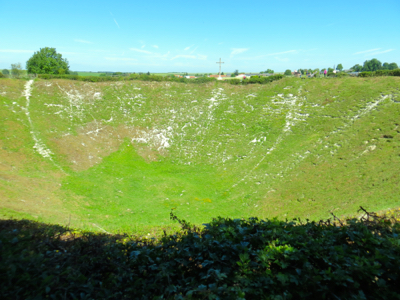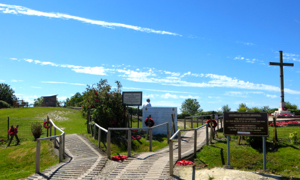 |
Lochnagar Crater, La Boiselle, France | |
| A peaceful green area along a quiet road...but the size of a massive explosion and loss of life in World War I. | ||
|
|
|
The area around Albert, in northern France, is full of World War I memorials and monuments, since this was the Western Front, site of long and bloody battles. One of the more unusual sites is the Lochnagar Crater, just 4.4 kilometers (almost 3 miles) northeast of Albert (map), just south of the village of La Boisselle. Sometimes referred to as the Trou de Mine, or mine hole, this huge crater resulted from a mine explosion at 7:28 AM on July 1, 1916. British tunnellers had worked for weeks to dig under the German lines and place 30 tons of explosives. Two charges, one of 36,000 pounds (16,300 kilos) and the other of 24,000 pounds (10,866 kilos) were detonated in two chambers that were 60 feet/18 meters apart, and 52 feet/16 meters underground. The tunnel was over 1000 feet/305 meters long. The resulting explosion sent debris some 4,000 feet/1200 meters into the air and created a hole 70 feet/21 meters deep and 300 feet/91 meters in diameter. That's about the size of an American football field.
It also took out several hundred feet/meters of German dugouts, and the troops that were in them. Despite this massive destruction, there were still many Germans left, and the battle was long and bloody, with tremendous loss of life on both sides. The Battle of the Somme raged on all around, and over the course of this long battle over one million people were killed or wounded. After the war, the crater remained, a grim reminder of the battle. It was used by motorcycles and there was talk of filling it in, but some felt it should be kept as a memorial. In 1978, an Englishman named Richard Dunning bought Lochnagar Crater, with the intention of preserving it as an important historical site. Each July 1 there is a commemoration, and about 200,000 people visit the site each year. A memorial cross has been erected, and a series of panels explain about Lochnagar, the battles, and some of the individuals who fought there. The site is open daily, and there is no charge. It is a moving reminder of the power and destruction of war. The Friends of Lochnagar, a group of World War I devotees, maintain a website and are active in the commemorations and preservation of Lochnagar Crater. More...
|
|
Above, Entrance to Lochnagar Crater, World War I Memorial, La Boiselle, France.
|



